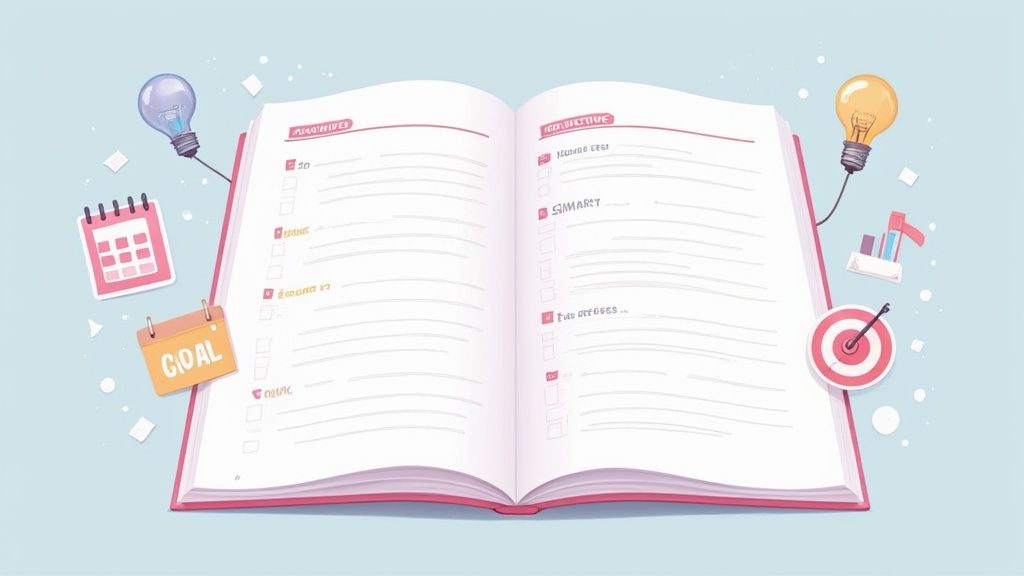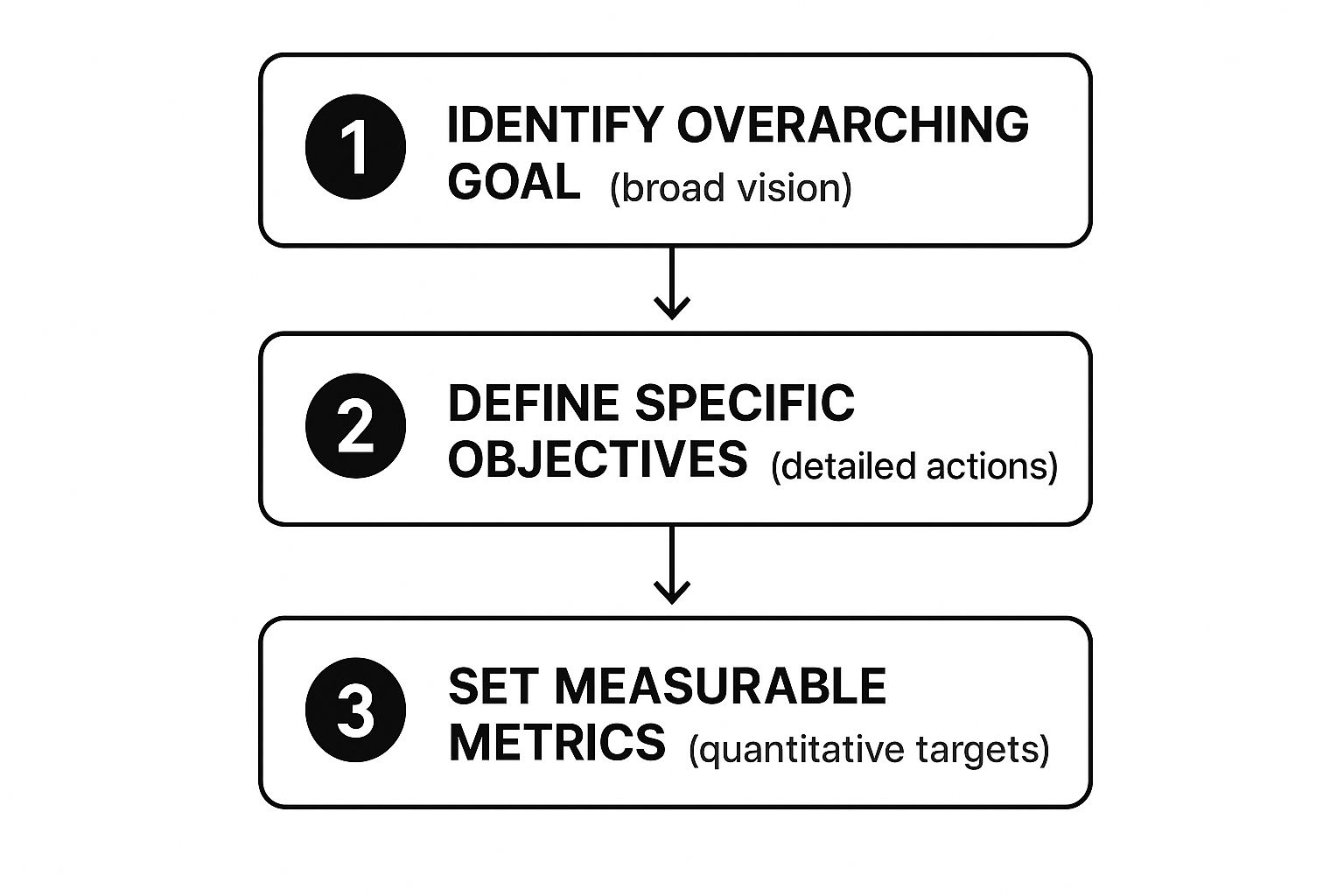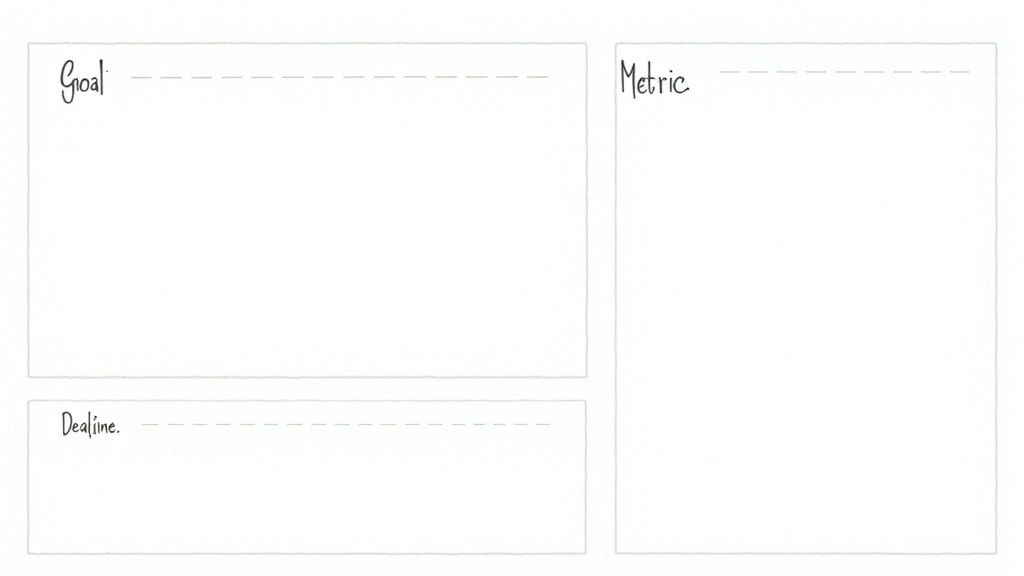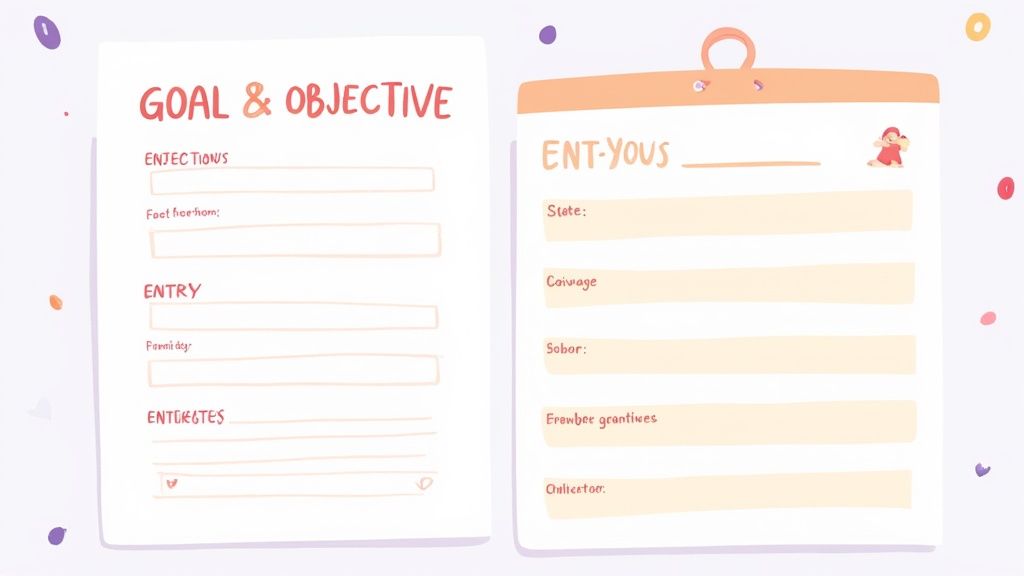Your Goal and Objective Template for Success
Your Goal and Objective Template for Success

A goal and objective template isn't just a document; it's the bridge that turns your big ambitions into clear, actionable steps. It's what takes you from a simple to-do list to a dynamic system for real achievement. Using a template ensures every goal you set is well-defined, measurable, and tied to your larger purpose.
From Ambition to Action with a Goal Template

Just having goals isn't enough to make them happen. The real magic is in translating those aspirations into a concrete plan. This is where a well-designed goal and objective template becomes your most valuable tool, giving you the clarity and drive you need to get moving. The key is to build a living system that adapts and grows with you.
Why a Structured Template Matters
A structured approach does more than just organize your thoughts—it builds momentum. The simple act of writing down your goals creates a psychological contract with yourself, dramatically boosting your chances of success.
When you bring this process into a tool like Obsidian, you're not just writing goals; you're creating an interconnected web of ambitions, plans, and daily actions. This is where products like Obsibrain truly shine, offering a pre-built system designed to manage these connections right out of the box.
A goal without a plan is just a wish. A template gives your wish a roadmap, turning abstract desires into a step-by-step journey toward a tangible destination.
To see this in action, it's often helpful to look at how others structure their plans. Exploring various employee goal setting templates can offer a solid starting point. These examples often highlight the core components needed for effective planning, whether for personal growth or professional development.
One of the most powerful frameworks for goal setting is SMART—ensuring your goals are Specific, Measurable, Achievable, Relevant, and Time-bound. Google put this to the test when they aimed to grow Chrome's user base. The team set a clear SMART goal: reach 100 million users in three years, complete with specific annual targets.
Even though they missed some early marks, the clear structure kept them on track. In the end, they didn't just meet their goal; they blew past it, reaching over 111 million users by their deadline. This is a perfect example of how a well-defined framework can guide a team to incredible results.
A good template needs a few core elements to be truly effective. This table breaks down the essentials you'll want to include.
Key Components of an Effective Goal Template
Goal Title
A clear, concise name for your goal.
Description
A brief explanation of what you want to achieve and why it's important.
SMART Criteria
Dedicated sections to define how the goal meets each part of the SMART framework.
Key Milestones
The major steps or phases required to reach the goal.
Actionable Tasks
The specific, smaller tasks needed to complete each milestone.
Deadlines
A target completion date for the overall goal and for each milestone.
Progress Tracker
A way to measure and visualize your progress, such as a percentage or status update.
Success Metrics
The specific outcomes that will define success (e.g., "increase sales by 15%").
Notes & Reflections
A space to jot down ideas, challenges, and lessons learned along the way.
By building these components into your template, you create a comprehensive and dynamic tool that not only outlines your goals but actively helps you achieve them. In a system like Obsibrain, these components are often built into pre-designed templates, so you can focus on defining the goal itself rather than building the structure from scratch.
Alright, let's roll up our sleeves and build your very first goal template in Obsidian. This is where the magic happens, moving you from just jotting down ideas to creating a real, actionable system for achieving what you want.
We'll start with a basic structure you can copy and paste right into a new note. The best place for this is a dedicated "Templates" folder in your vault to keep things organized.
The real power of Obsidian is its incredible flexibility. Even a simple template, built with plain text and markdown, can create a surprisingly robust foundation that's easy to tweak and quick to use.
This whole process is about connecting your big-picture vision to specific, measurable actions. Think of it like this:

As you can see, solid planning starts high-level, breaks down into clear objectives, and finishes with concrete metrics you can actually track.
Your Essential Template Structure
Let's get the core components in place. Create a new note—maybe call it "Goal Template"—and drop in the following markdown. This structure gives you placeholders for all the crucial elements of your goal, making sure you don't miss a thing.
🎯 Goal: [Your Goal Title]
Status: 🔵 Not Started Target Date: Date Created: <% tp.file.creation_date("YYYY-MM-DD") %>
📝 Description & Purpose
A brief summary of what I want to achieve and why it matters to me.
🎯 SMART Criteria
Specific:
Measurable:
Achievable:
Relevant:
Time-bound:
🗺️ Key Milestones
📓 Progress Log & Reflections
Weekly notes on progress, challenges, and lessons learned.
Pro-Tip: That
<% tp.file.creation_date("YYYY-MM-DD") %>bit is a small piece of code for the Templater community plugin. It automatically stamps your note with the creation date whenever you use the template. It's a tiny time-saver that really adds up.
This simple layout gives you a fantastic framework. You’ve got a clear title, a spot for your "why," dedicated fields for the SMART framework, and a checklist for your key milestones. It instantly transforms a scary blank page into a focused plan of attack.
While this is a great starting point, tools like Obsibrain take this concept even further. They come with pre-built, advanced goal templates that hook directly into task management and daily note systems. If you're curious about how to link your high-level goals to your day-to-day actions, you can explore task management features in our documentation. This creates a powerful feedback loop that's essential for driving consistent progress.
Integrating the SMART Framework into Your Plan

Look, having a goal and objective template is a great first step. But the real magic happens when you infuse it with a proven system like the SMART framework. This is what turns a fuzzy wish into a concrete plan you can actually follow.
Let's break down how to bake this right into your Obsidian setup. Each piece of SMART—Specific, Measurable, Achievable, Relevant, and Time-bound—has a job to do. By weaving them into your template, you move from "I want to get better at something" to "I will achieve this specific outcome by this specific date." It’s a total game-changer.
Making Your Goals Specific and Measurable
A Specific goal cuts through the noise. It answers the "what" and "why" right away. Instead of a vague goal like "Improve my website," you get laser-focused: "Redesign the website homepage to improve user engagement." Instantly, you know where to start.
Next up, Measurable. How will you know you're winning? This is where you define your Key Performance Indicators (KPIs). For that website redesign, you could track things like:
A 20% decrease in bounce rate.
An increase in average time on page by 45 seconds.
A 10% lift in newsletter sign-ups coming from the homepage.
This isn't just for personal projects; businesses have been using goal templates for ages to drive strategic success. A common business goal wouldn't be 'increase revenue,' but rather 'Increase monthly sales by 15% within the next fiscal year.' It's the same principle of clarity and measurement. You can see more examples of how businesses leverage goal templates on empmonitor.com.
Keeping Goals Achievable and Relevant
A goal has to feel Achievable. It should stretch you, but not snap you. If a goal feels too big, it's easy to get discouraged and quit.
The beauty of Obsidian is how easily you can break massive goals down. Just use the checkbox feature to turn a giant milestone into a series of smaller, satisfying tasks you can check off. That little bit of momentum makes all the difference.
Finally, your goal must be Relevant. Does this objective actually matter to your bigger picture? This is where a system like Obsibrain shines, letting you visually link your daily tasks and projects back to your core "Pillars" or life goals. It’s a simple way to ensure the work you're doing today is pushing you in the right direction. For instance, when setting a goal, you can tag it with a relevant life pillar (e.g., #pillar/career), creating an instant, organized connection.
Vague Goal: "Get more clients for my freelance business."
SMART Goal: "Secure three new freelance writing clients by the end of Q3 by sending 20 personalized pitches per week and increasing my portfolio's visibility on LinkedIn, which aligns with my long-term goal of building a sustainable solo business."
This kind of structured thinking, embedded right into your template, is what separates dreaming from doing.
Visualize Success with Obsibrain and Dataview
Once you've got a solid goal and objective template, the real magic happens when you make it dynamic. Your goals shouldn't just sit in isolated files. They need to be part of a living system that gives you real-time feedback on your progress. This is where a couple of incredible community plugins, Obsibrain and Dataview, come in to turn your static notes into an interactive command center.
The goal here is to connect your big-picture ambitions with the work you do every single day. Seeing that connection is what keeps you going, as it constantly reminds you why you're doing what you're doing.
Connect Goals to Daily Actions with Obsibrain
One of the best ways to see these connections is with the Obsibrain plugin. It’s fantastic for creating visual mind maps of all your notes.
Imagine a central node in your graph view labeled "Launch New Website." From there, you see branches shooting out to your project files for "Design Mockups," "Write Homepage Copy," and "Develop Backend." This isn't just a pretty picture; it's a live, visual map of your progress. Obsibrain is specifically designed for this, providing structured folders for Goals, Projects, and Pillars that automatically link together, making this visualization effortless.
When you can literally see how a small task you knocked out today links back to that major goal, it gives you a serious motivational boost. This visual feedback loop is a game-changer for staying on track, especially with long-term projects. It turns abstract goals into a tangible network of actions.
Seeing your goals visually linked to your daily efforts makes progress feel more real. It transforms your to-do list from a series of chores into a clear path toward a meaningful outcome.
Create an Automated Dashboard with Dataview
While Obsibrain gives you the visual "why," the Dataview plugin handles the "what" by automating your tracking. By adding a simple query to a central "Dashboard" note, you can pull in key details from all your goal files at once. This creates a single source of truth for everything you're working towards.
Here’s a simple Dataview query you can pop into a note to get started. This little script will find all notes you've tagged with #goal that aren't finished yet and organize them into a clean table.
TABLE status, target_date, file.mtime as "Last Updated" FROM #goal WHERE status != "✅ Completed" SORT target_date ASC
This simple code block turns a blank note into your personal accountability partner. Your dashboard will instantly show you:
Which goals are currently active.
Their upcoming deadlines, sorted so you know what's next.
When you last touched each goal file, which is great for seeing what needs attention.
With this setup, you can stop hunting through folders for updates. Your goal and objective template now fuels a dynamic system that keeps you focused, organized, and totally in the loop with just a single glance. Obsibrain comes with pre-configured dashboards that use Dataview, saving you the setup time and providing instant oversight of your goals and projects.
When your ambitions start to outgrow simple personal goals and you're dealing with team projects or more complex initiatives, the SMART framework can sometimes feel a bit restrictive. That's the perfect time to bring in the Objectives and Key Results (OKR) framework. It’s a fantastic way to scale up your planning.

At its heart, the OKR model is simple. It revolves around two key pieces: a big-picture, aspirational Objective and a handful of measurable Key Results that tell you if you've actually achieved it.
Think of it this way: The Objective is the mountain you want to climb. The Key Results are the specific checkpoints—like reaching base camp or a certain altitude—that prove you're making real progress.
This structure is a game-changer for a team-based goal and objective template. It creates incredible clarity and alignment because everyone on the team can see exactly how their work connects to the larger goal. If you need a hand brainstorming, an online OKR Generator can be a great starting point.
Your OKR Template Snippet For Obsidian
It's really easy to build this framework right into Obsidian for your quarterly planning. Here’s a basic markdown snippet you can drop into a new note to get started:
Objective: [Inspiring, high-level goal for the quarter]
KR 1: [Measurable outcome 1 with a specific target]
KR 2: [Measurable outcome 2 with a specific target]
KR 3: [Measurable outcome 3 with a specific target]
This isn't just theory; it has a real impact. For example, when Sears Holding Company rolled out OKRs to 20,000 of its employees, they saw an 8.5% bump in hourly sales. It’s a powerful system for focusing effort.
The real magic of OKRs is how they bridge the gap between ambitious dreams and concrete, measurable progress. It shifts the team's focus from just completing tasks to achieving a shared mission where everyone can see the needle moving.
For this to work, each person needs to connect their daily work back to the Key Results. This is where a tool like Obsibrain shines. You can directly link your assigned Key Results to your daily notes and tasks, creating a clear line of sight between what you're doing today and the team's big-picture objectives. A typical use case in Obsibrain involves creating a project note for each Key Result, then linking all related tasks and meeting notes to that project. This builds an automatic, traceable record of progress.
This tight integration helps you stay focused and build momentum. If you're looking for more ways to stay consistent, check out our guide on how Obsibrain helps with habits tracking. It ensures that every small action you take is deliberately contributing to the larger team goals.
It’s only natural to have a few questions when you’re getting the hang of a new system. Let's tackle some of the common sticking points people run into when using a goal and objective template in Obsidian. Getting these sorted will help you move forward with confidence.
How Often Should I Review My Goals?
The best review cadence really depends on the goal's timeline.
For your big-picture ambitions—think quarterly or annual goals—a dedicated weekly review is a great rhythm. This gives you enough runway to make meaningful progress between check-ins, but it’s frequent enough to keep the objective from falling off your radar. You can track milestones, tweak your approach, and keep the motivation high without feeling swamped. Obsibrain facilitates this with a dedicated 'Weekly Review' template that prompts you to check in on your goals and projects.
But for smaller, more immediate goals? A quick check-in during your Daily Note works wonders. Just link your daily entry back to the main goal file, and you’ll keep your priorities front and center.
The key is consistency. Your review schedule should match the goal's scope. This simple habit turns goal-setting from a one-off event into a continuous practice of intentional progress.
What Is the Difference Between a Goal and an Objective?
It's a great question, and the distinction is crucial for getting things done.
Think of it this way: a Goal is your broad, strategic vision. It’s the "what" you want to achieve. A perfect example would be, "Launch a successful podcast." It's big and inspiring.
Objectives, on the other hand, are the specific, measurable steps you’ll take to make that goal a reality. They are the tactical "how." For our podcast goal, your objectives might look something like this:
Publish 12 episodes by the end of Q3.
Secure 3 guest interviews before the official launch.
Reach 500 downloads per episode within the first month.
Objectives are what break your ambitious goal into smaller, manageable chunks that you can actually track. Within Obsibrain, a Goal would live in the 'Goals' folder, while each Objective could be set up as a 'Project' linked to that goal, neatly organizing the hierarchy.
Can I Use This Template for Team Projects?
Absolutely. In fact, the OKR (Objectives and Key Results) structure baked into the template is practically built for team collaboration.
When you're working in a shared Obsidian vault or another collaborative space, the team can establish a central Objective that everyone is rallying behind. From there, individual team members can take ownership of specific Key Results.
This approach creates incredible alignment. It makes it crystal clear how each person's daily work directly contributes to the team's overall success. This becomes even more powerful inside Obsibrain, where you can visually link high-level team goals all the way down to individual tasks and projects. If you want to get a better handle on the concept, check out our guide on what a template is in our documentation.
Ready to stop switching between apps and start centralizing your ambitions? Obsibrain provides a complete, science-backed system inside Obsidian to manage your goals, tasks, and notes in one place. Get lifetime access and start building your future today at https://www.obsibrain.com/en.
Last updated
Was this helpful?